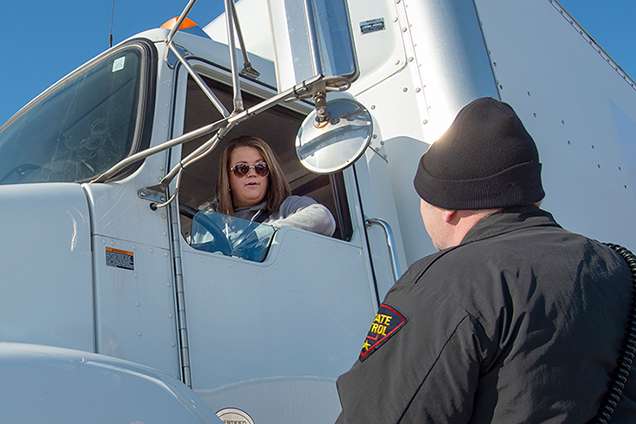Sr. Industry Business Advisor, J. J. Keller & Associates, Inc.
The Driver's Roadside Inspection: No Surprises, No Excuses

There are No Surprises in a Driver Roadside Inspection
While a vehicle could experience an unexpected maintenance event on the road that would impact the success of a roadside inspection, the driver's roadside inspection protocol is well-documented, leaving little excuse for a driver who has a violation or is placed out-of-service.
Consider the following reasons a driver could be placed out of service:
- Their driver's license has been suspended, revoked, downgraded, disqualified, etc.
- The driver doesn't have the correct license for the vehicle he/she is operating;
- The driver is impaired by illness, fatigue, drugs, or alcohol;
- The driver can't provide logs and a reasonable explanation as to why he/she doesn't have logs; or
- The driver is currently out of hours or has a false log.
The fact is that all of these circumstances are within the driver's control. But let's take a deeper look at the process step-by-step.
Driver Roadside Inspection Process
FIRST IMPRESSIONS
Vehicle Visual — An officer will look at the general condition of the vehicle. The more mechanical problems the officer sees, the more likely they are to do a full inspection.
Driver Visual — The officer will observe driver actions, including excessive fidgeting, attempts to rearrange items in the cab, reaching for something, or trying to stay out of sight.
Greeting — The officer will greet the driver and begin the interview. Questions will include:
- Driver name
- Company
- Freight hauling
- Trip origin and destination
- Issues encountered on the trip
Impairment Check — The officer will determine if the driver is impaired by illness, fatigue, drugs, or alcohol. If the driver appears to be impaired, the officer will attempt to determine the exact problem, including the use of additional assessments or tests.
DOCUMENT VERIFICATION
Carrier Documentation — The officer will verify that:
- The carrier's DOT number is current and not inactive
- The carrier is not under an out-of-service order
- The carrier's UCR is current (if an interstate carrier)
- The carrier has valid for-hire authority if acting as a for-hire carrier
- The vehicle's required credentials are correct and valid
Load Documentation — The officer will review documents provided to determine if the vehicle is transporting hazardous materials.
Driver Documentation — The officer will verify the driver's qualifications, including:
- Running the driver's license to get a motor vehicle report (MVR) and verifying the license is current and valid, including the class, endorsements, and restrictions on the license
- Verifying the driver is medically qualified, complying with any medical terms listed on either the license or the medical card, and that the driver has the necessary exemption for a condition that is typically disqualifying
DUTY STATUS RECORDS
This part of the inspection is more involved and includes the officer requesting and reviewing the driver's records of duty status, along with supporting documents (bills of lading, shipment paperwork, and toll or fuel receipts).
How they proceed depends on the type of log the driver uses — ELD, paper logs, or exempt time records. (Download the DOT Roadside Inspections Guide for a detailed explanation of these processes.)
Regardless of the method, the officer will examine the logs for the current and previous seven days, looking for:
- The use of the correct type of log (electronic or paper)
- Missing information or entries
- Incidents of operating past a limit
- Falsification
DRIVER VEHICLE INSPECTION REPORTS (DVIRS)
The regulations do not require the driver to carry previous DVIRs, but an officer can request that the driver present DVIRs in their possession. A significant fine could be levied if it's evident that the driver and carrier have been knowingly operating a vehicle with a defect that affects the vehicle's safety or if a DVIR indicates a defect that has not been addressed.
ANNUAL (PERIODIC) INSPECTION
Finally, the officer will verify the vehicle has a current annual inspection. Combination vehicles of a truck or tractor and a trailer (or multiple trailers) require proof of annual inspection for each piece of equipment. Proof can be a copy of the annual inspection or a decal with the date of inspection.
In Conclusion
It's clear that a successful driver roadside inspection is determined long before the driver approaches the checkpoint. On average, five percent of driver roadside inspections result in an out-of-service order. Realistically, that number should be close to zero. And it's not all on the drivers. Carriers have a vested interest in ensuring perfect roadside inspections as roadside inspection scores — good and bad — impact how enforcement, insurance, litigators, and the motoring public view their company.
Download our comprehensive Roadside Inspection Checklist to prepare your entire organization. It includes guidance for carriers, drivers, and maintenance professionals.
J. J. Keller & Associates, Inc. is the most respected name in safety and regulatory compliance. Since its beginning as a one-man consulting firm in 1953, the company has grown to over 1,500 associates serving more than 500,000 customers — including over 90% of the Fortune 1000® companies. The company's subject-matter expertise spans nearly 1,500 topics, and its diverse solutions include ELogs and mobile technology; training via online courses, streaming video or DVD; online management tools; managed services; consulting services; online and print publications; forms and supplies.
Transportation professionals rely on J. J. Keller's in-house expertise and wide selection of products and services to reduce risk and improve regulatory compliance, performance management, and operational efficiency. For more information, visit JJKeller.com
The above article is sponsor-generated content. To learn more about sponsor-generated content, click here.


